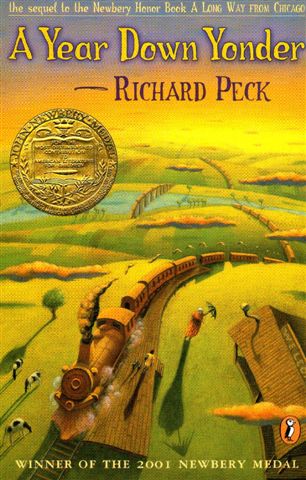 While browsing the Newbery winner shelves of my hometown library's juvenile department, I discovered Richard Peck's A Year Down Yonder. The cover art persuaded me to take a closer look, as usual, and in this case, the old addage was proven false. I judged this book by its charming cover, and my judgements were absolutely right!
While browsing the Newbery winner shelves of my hometown library's juvenile department, I discovered Richard Peck's A Year Down Yonder. The cover art persuaded me to take a closer look, as usual, and in this case, the old addage was proven false. I judged this book by its charming cover, and my judgements were absolutely right!Richard Peck's works have, somehow, completely evaded me. This winner of multiple literary awards including the Edgar Allan Poe Award, National Book Award, a Newbery Honor, and a Newbery Medal has made great contributions to juvenile literature through his mostly historical fiction works.
The sequel to A Long Way from Chicago, A Year Down Yonder, will not disappoint! The story follows Mary Alice, a teenager from Chicago who is sent to stay with her Grandma Dowdell out in the country. It's 1937, and as her parents struggle to make a living back home, Mary Alice struggles to adjust to her new life in a small, rural community living with her larger-than-life, tough-as-nails Grandma Dowdell. Peck has created a mini masterpiece in this short book. The real story here is the relationship between grandmother and granddaughter. A reader may start out the book thinking it will chronicle the "outrageous" scenarios of a city girl in a country town. Instead, with humor, a quick tempo, and dignity, Peck seemlessly exposes Grandma Dowdell's true colors and the love between her and Mary Alice. This coming-of-age story also subtly gives the reader a window into life in the late 1930s not only through setting and story events but by touching on Armistice Day, the Great Depression, and the two World Wars.
If this is any indication of how much I enjoyed A Year Down Yonder, I was sad to see the end of the book. But I hurried to the library and picked up one of his latest books: On the Wings of Heroes (2007)!
